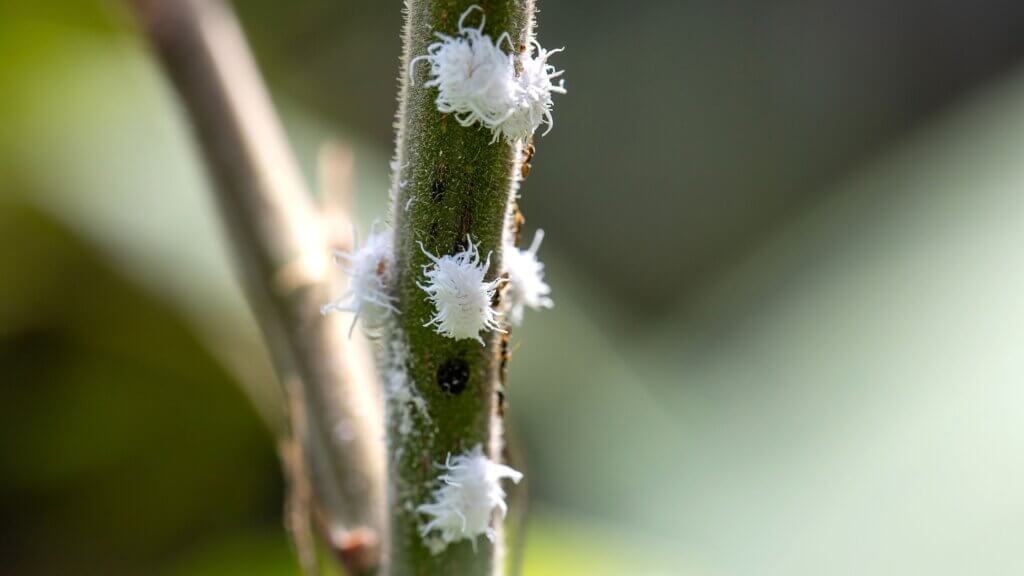Mealybugs are a common pest that can wreak havoc in your garden or indoor plants if left untreated. These tiny, white, cotton-like insects cluster on plant stems, leaves, and roots, sucking sap and weakening plants. If you’ve noticed white, fuzzy spots on your plants, it could be a mealybug infestation. We’ll explore how to identify mealybugs and their impact on plants, and the best ways to get rid of mealybugs. Below are listed South African products to get rid of mealybugs
What Are Mealybugs?
Mealybugs are small, soft-bodied insects that are typically covered in a white, powdery, or waxy coating, making them look like tiny pieces of cotton or fluff. They feed by sucking the sap from plants, which can weaken and damage the plant over time. Mealybugs are usually found in clusters on the undersides of leaves, at the joints of stems, or along plant stems. As they feed, they excrete a sticky substance called honeydew, which can attract ants and lead to the growth of black sooty mold on the plant’s surfaces.
These pests are common in warm, humid environments and can infest a wide range of plants, including houseplants, ornamentals, fruit trees, and vegetables. They are especially troublesome because they hide in hard-to-reach places, making them difficult to spot and treat early on. Left untreated, mealybugs can stunt plant growth, cause leaves to yellow and drop, and in severe cases, lead to plant death.
How to Identify Mealybugs If You Don’t Know the Name
If you’ve noticed small, white, cotton-like clusters on your plants and you’re unsure what they are, you might be dealing with mealybugs. People often describe them as “tiny white bugs on plants” or “fluffy white insects.” You might see them on the undersides of leaves, along the stems, or in hidden areas like the joints where leaves meet the stem. These pests often cause plant leaves to turn yellow, wilt, or fall off. You may also notice a sticky residue (honeydew) or black mold forming around the areas where these insects gather.
If you’re searching online, you might look up terms like:
- “tiny white bugs on plants”
- “white fluffy bugs damaging plants”
- “sticky stuff on leaves and black mold”
- “how to get rid of cotton-like bugs on plants”
These searches will likely lead you to the correct identification of mealybugs, a common garden and houseplant pest that can be managed with the right treatment.
Identifying Mealybugs and Infestations
Mealybugs can be tricky to spot in the early stages because they often hide in nooks and crannies on plants. However, their distinctive appearance makes them easy to recognize once you know what to look for.
How to Recognize Mealybugs:
- Appearance: Adult mealybugs are small, oval-shaped insects with a white, waxy coating that looks like tiny tufts of cotton. They often cluster together on plant stems, leaves, or fruit.
- Feeding Signs: Mealybugs feed by sucking sap from plants, causing leaves to yellow, curl, or drop prematurely. You might also notice stunted growth or a sticky residue (honeydew) on your plants.
- Honeydew and Sooty Mold: Mealybugs excrete honeydew, which can lead to the growth of black sooty mold on leaves. This mold doesn’t harm plants directly but blocks sunlight and hinders photosynthesis.
- Location: Mealybugs are often found in sheltered areas, such as the joints of leaves, under leaf stems, or even on roots in the case of root mealybugs.
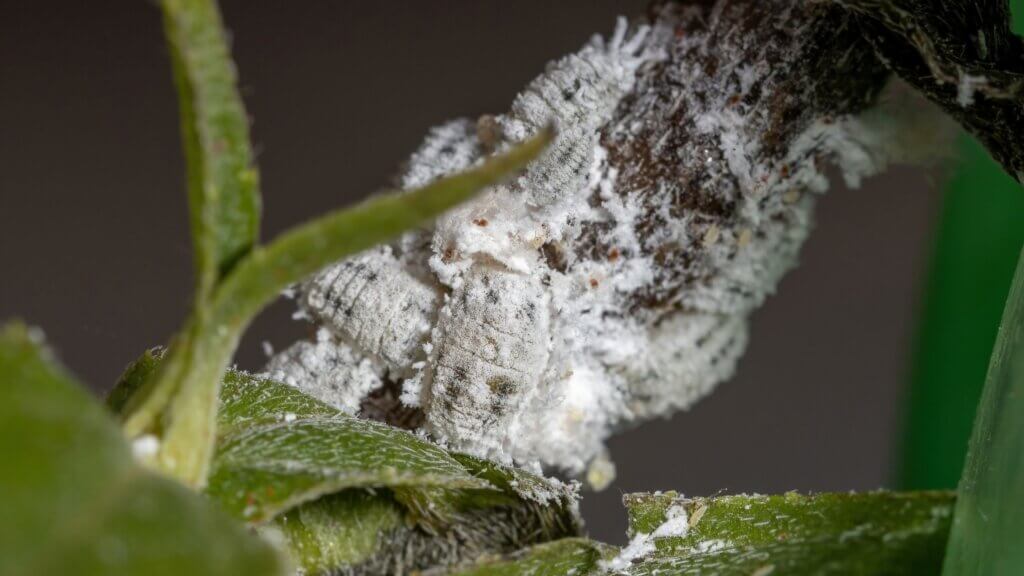
Look for Mealybugs on Indoor and Outdoor Plants
Mealybugs can become a persistent problem for both indoor and outdoor plants, particularly in warm, sheltered environments. While they are capable of attacking plants year-round, they thrive in conditions where natural predators and the elements—such as rain and wind—cannot reach them. Whether you have houseplants, a patio garden, or maintain a greenhouse, understanding where mealybugs are most likely to hide will help you take early action before an infestation gets out of hand.
Mealybugs on Indoor Plants
Indoor plants are especially vulnerable to mealybugs because they are typically grown in controlled, sheltered environments. The lack of weather changes and absence of natural predators like ladybugs and parasitic wasps means that mealybugs can establish themselves quickly and reproduce unchecked.
Where to Look Indoors:
- Leaf Joints and Undersides: Mealybugs prefer to hide in the nooks and crannies of plants, especially where leaves attach to the stem or along the undersides of leaves. These areas offer protection and make it difficult to spot the pests early on.
- Soil and Pot Rims: Mealybugs don’t just hide on the plant itself. They can also be found at the base of the plant near the soil, particularly around the pot rims or drainage holes. Root mealybugs can infest the soil, attacking plant roots and causing wilting or yellowing leaves despite proper watering.
- Dense Foliage and Hard-to-Reach Places: Plants with dense, bushy foliage or those in hanging baskets are more likely to harbor hidden mealybugs. The close-knit leaves create a perfect microclimate for mealybugs to thrive unnoticed.
Mealybugs on Outdoor Plants
Outdoors, mealybugs are more commonly found in sheltered or protected areas where they can avoid natural elements like rain, which would otherwise wash them off plants. They often invade plants that are near walls, patios, or in greenhouses, where the conditions are more stable and warm. Even in outdoor settings, mealybugs often hide in areas that provide them some degree of shelter from predators and weather.
Common Places to Check Outdoors:
- Greenhouse Corners and Humid Spaces: Greenhouses are prime targets for mealybugs due to the warm, humid conditions that encourage rapid reproduction. Mealybugs can often be found clustering on plants in hard-to-see areas, such as the back of leaves or hidden under pots.
- Plant Stems and Branches: On outdoor plants like roses, citrus trees, and succulents, mealybugs will often cluster along the stems and branches. They feed on the sap, leaving behind sticky honeydew, which can attract ants and encourage mold growth.
- Fruit and Flowering Areas: For fruiting plants like tomatoes or citrus trees, mealybugs often target the fruit itself, stunting growth and causing damage that can lead to poor yields or unsightly fruits.
The Impact of Mealybugs on Plants and Gardens
Mealybugs can cause serious damage to both indoor and outdoor plants. If not treated, they can weaken your plants to the point of no recovery, especially if the infestation spreads.
Why Mealybugs are Harmful to Plants:
- Sap-Sucking Damage: Mealybugs feed by extracting nutrients from plants, causing leaves to yellow, drop, and stunt plant growth.
- Plant Weakening: Over time, the plant becomes weaker, making it more susceptible to diseases and other pests.
- Root Damage: Some species of mealybugs, such as root mealybugs, feed on plant roots, leading to wilting and death in severe cases.
- Honeydew and Ants: The honeydew secreted by mealybugs attracts ants, which protect them from predators, allowing the infestation to spread unchecked.
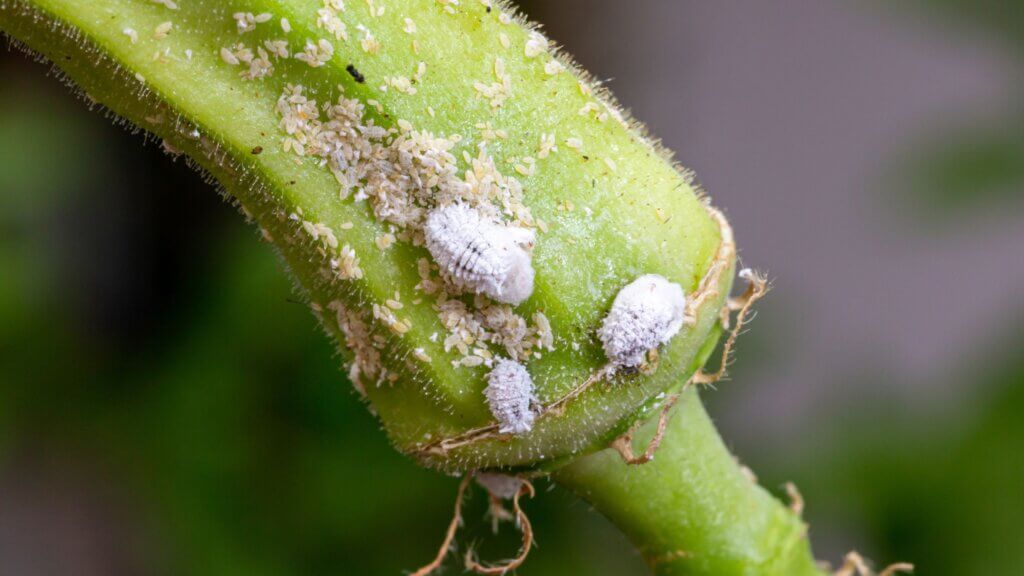
Dealing with mealybugs requires prompt action to prevent them from spreading to healthy plants. There are several methods to eliminate mealybugs, from chemical treatments to natural remedies. Below are the most effective ways to tackle mealybug infestations.
Chemical Solutions to Get Rid of Mealybugs
Chemical insecticides are often the quickest and most effective option for large or persistent mealybug infestations. These products work by targeting the mealybugs directly, killing them on contact or through systemic absorption.
Top Chemical Products for Mealybug Control:
Protek:
- Protek Imidor 350 SC: A systemic insecticide that is absorbed by the plant, effectively killing mealybugs as they feed on treated plant tissues.
- Protek Kemprin 200 EC: A fast-acting contact insecticide with a broad spectrum of action, ideal for quickly eliminating mealybugs on contact.
- Protek Spray-Kill 3: A versatile insecticide that offers both contact and stomach action, efficiently targeting mealybugs and preventing further damage to plants.
Efekto:
Efekto Garden Ripcord: This is a contact and stomach insecticide containing a synthetic pyrethroid. It works quickly by killing mealybugs on contact and is effective for use on ornamental plants, fruit trees, and vegetables.
Efekto Insecticide Granules Plus: A systemic insecticide in granular form that is applied to the soil, allowing the plant to absorb it through its roots. This product effectively targets sap-sucking insects like mealybugs, providing long-term control from the inside.
Efekto Malasol: A strong contact insecticide that targets soft-bodied insects like mealybugs. It disrupts their feeding, making it an excellent choice for heavy infestations on ornamental plants and crops.
Makhro Home and Garden
Makhro Cyper: A contact and stomach insecticide that works effectively on mealybugs. It contains Cypermethrin, a pyrethroid, which kills mealybugs on contact, making it ideal for use on flowers, ornamentals, and in home gardens.
Koinor 350 SC: This systemic insecticide contains Imidacloprid and is absorbed by plants, making it effective against mealybugs that feed on plant sap. It provides long-lasting control, targeting mealybugs and other sap-sucking pests.
Makhro Organicide: A natural option, this organic insecticide uses Canola oil and garlic extract to suffocate mealybugs while being safe for use on edible crops, flowers, and ornamental plants. It’s ideal for gardeners looking for eco-friendly pest control.
Kombat
- Cypermethrin is a fast-acting insecticide that works by attacking the nervous system of mealybugs upon contact. As a synthetic pyrethroid, it provides rapid knockdown of these pests, making it highly effective for both indoor and outdoor use. It’s ideal for protecting plants like ornamentals and vegetables, and its long-lasting residual action ensures continued control even after the initial application.
- Malathion is a broad-spectrum insecticide that effectively targets mealybugs by disrupting their nervous system. It works both on contact and ingestion, making it particularly useful for large-scale infestations. Suitable for fruit trees, vegetables, and ornamental plants, it provides fast-acting and long-lasting protection, helping to manage severe mealybug infestations with minimal effort.
- Cypermethrin is a fast-acting insecticide that works by attacking the nervous system of mealybugs upon contact. As a synthetic pyrethroid, it provides rapid knockdown of these pests, making it highly effective for both indoor and outdoor use. It’s ideal for protecting plants like ornamentals and vegetables, and its long-lasting residual action ensures continued control even after the initial application.
Safety When Using Chemical Insecticides
When using chemical insecticides, it’s important to follow all safety guidelines provided by the manufacturer. Always wear protective gear such as gloves, goggles, and masks to avoid skin contact or inhalation of chemicals. Be cautious about applying these products on windy days to prevent drift to non-target plants, and keep children and pets away from treated areas until the product has dried or as per label instructions. Ensure you store insecticides safely and dispose of empty containers according to local regulations to protect the environment.
Natural and Organic Mealybug Control Solutions
If you prefer a more eco-friendly approach, there are several organic methods to control mealybugs. These solutions are safe to use around pets, children, and beneficial insects, making them ideal for home gardens, vegetable patches, and indoor plants.
Popular Organic Mealybug Control Products:
Makhro Organicide:
- A powerful organic insecticide, Makhro Organicide combines natural ingredients such as Canola oil, garlic extract, and pyrethrum. It effectively targets mealybugs, aphids, and other soft-bodied pests while being safe for use on vegetables, flowers, and fruit trees.
- A powerful organic insecticide, Makhro Organicide combines natural ingredients such as Canola oil, garlic extract, and pyrethrum. It effectively targets mealybugs, aphids, and other soft-bodied pests while being safe for use on vegetables, flowers, and fruit trees.
Kirchhoff’s Margaret Roberts Organic Insecticide:
- This trusted eco-friendly product uses Canola oil to suffocate mealybugs on contact. It’s a great option for gardeners looking for a non-toxic way to protect their crops, herbs, and ornamental plants.
- This trusted eco-friendly product uses Canola oil to suffocate mealybugs on contact. It’s a great option for gardeners looking for a non-toxic way to protect their crops, herbs, and ornamental plants.
Biogrow Bioneem:
- A natural solution derived from the neem tree, Biogrow Bioneem disrupts the feeding and reproduction of mealybugs. It’s an excellent choice for controlling mealybugs organically, without harming beneficial insects like bees.
Other Methods to Get Rid of Mealybugs:
- Neem Oil: Neem oil disrupts the mealybugs’ life cycle, preventing them from feeding and reproducing. It’s safe for most plants and can be applied regularly until the infestation is under control.
- Insecticidal Soap: This soap breaks down the mealybugs’ protective waxy coating, suffocating them. It’s a safe option for vegetables, fruits, and houseplants.
- Rubbing Alcohol: Dip a cotton swab in 70% isopropyl alcohol and dab it directly onto the mealybugs. The alcohol dissolves the waxy coating and kills them instantly. This method is highly effective for small infestations or isolated areas.
Plants Vulnerable to Mealybugs
Mealybugs can infest a wide variety of plants, from vegetables and fruits to succulents and ornamentals. Understanding which plants are at risk can help you monitor for infestations and act quickly.
Plants Commonly Affected by Mealybugs:
- Succulents: Mealybugs are particularly common on succulents, where they hide in tight spaces between leaves.
- Orchids: Mealybugs can cause significant damage to orchid leaves and flowers.
- Citrus Trees: Mealybugs feed on the stems and fruit of citrus trees, causing stunted growth and fruit damage.
- Tomatoes (Solanum lycopersicum): Mealybugs can cluster around the stems and leaves, reducing plant vigor and yield.
- Ferns and Houseplants: Indoor plants, particularly those in warm, humid environments, are often targets for mealybugs.
Preventing Mealybugs in Your Garden
Prevention is always better than cure when it comes to mealybugs. By taking a few simple precautions, you can reduce the likelihood of infestations and keep your plants healthy.
Tips for Preventing Mealybugs:
- Inspect New Plants: Always check new plants for signs of mealybugs before introducing them to your garden or home. Look for white, cottony clusters on the stems and leaves.
- Maintain Plant Health: Strong, healthy plants are more resistant to pests. Water your plants regularly, provide proper nutrients, and avoid over-fertilizing with nitrogen, which encourages soft growth that mealybugs love.
- Prune Infested Areas: Remove any heavily infested leaves or branches and dispose of them far away from your plants to prevent the infestation from spreading.
- Use Yellow Sticky Traps: These traps can catch flying mealybugs and help you monitor the infestation level in your garden.
- Increase Air Circulation: Mealybugs thrive in warm, humid environments. Improve air circulation by spacing plants properly and pruning dense foliage.
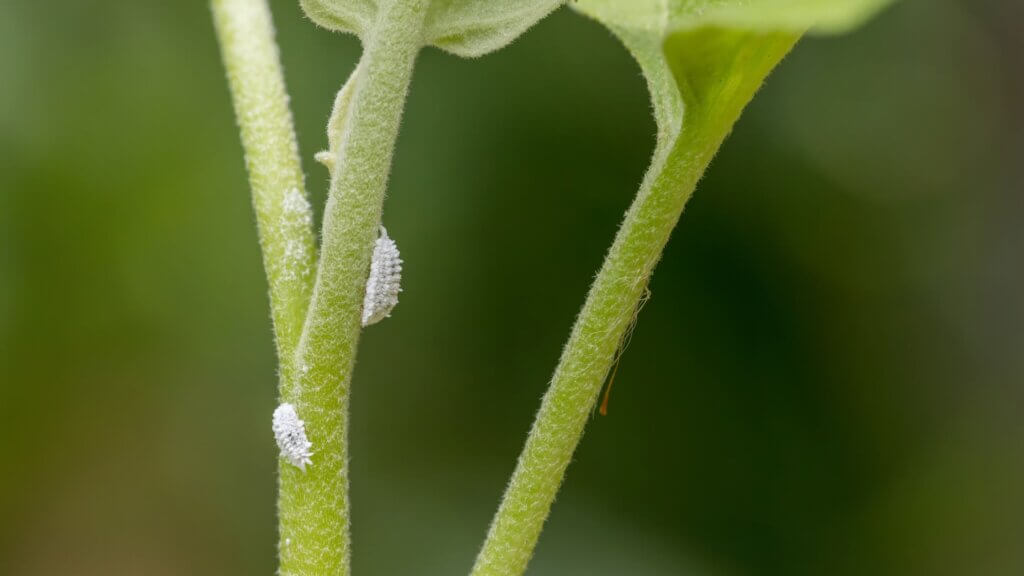
Questions on How to Get Rid of Mealybugs
How to get rid of mealybugs?
To get rid of mealybugs, start by identifying the infestation early. You can use either chemical insecticides or organic treatments. Some solutions work by suffocating the pests on contact, while systemic options get absorbed into the plant and kill mealybugs as they feed. For organic methods, natural oils and insecticidal soaps are effective. Always prune heavily infested areas and dispose of them far from the garden to prevent spreading.
How do I get rid of mealybugs in South Africa?
In South Africa, mealybugs can be controlled using both chemical and organic treatments mentioned earlier. These methods, combined with regular plant inspections, are particularly effective in the warm, sheltered environments common in the region. Use products designed for sap-sucking pests, apply them according to the instructions, and repeat treatments as necessary for lasting protection.
What causes mealybugs?
Mealybugs are often introduced to plants through contaminated soil, infested plants, or even on gardening tools. They thrive in warm, humid environments, and over-fertilized plants with excessive soft growth are especially attractive to them. Poor air circulation around plants can also contribute to infestations.
Does vinegar kill mealybugs?
Vinegar can act as a mild deterrent for mealybugs but is not recommended as a primary treatment. The acidity of vinegar can damage plant tissues, so it should be heavily diluted if used. Other natural treatments mentioned earlier, such as oils or insecticidal soaps, are safer and more effective for mealybug control.
What is the best natural killer for mealybugs?
The most effective natural solution is neem oil, which disrupts the feeding and reproduction cycles of mealybugs. Insecticidal soap and horticultural oils, both mentioned earlier, also work well by smothering the pests. These organic options are safe for plants and non-toxic to beneficial insects.
What kills mealybugs instantly with baking soda?
Baking soda itself is not typically used to kill mealybugs instantly. A better approach would be the organic treatments discussed earlier, such as insecticidal soaps or neem oil. Baking soda can, however, be used in DIY mixtures with other ingredients like soap to create a mild insect repellent.
What is the best insecticide for mealybugs on orchids?
For orchids, choose a systemic insecticide that can be absorbed by the plant and act from the inside out, or opt for organic options like neem oil or insecticidal soap. These are gentle on delicate orchid flowers while effectively controlling mealybugs.
Can turmeric remove mealybugs?
Turmeric is not known to be a reliable solution for mealybugs. While it may have antifungal and antibacterial properties, it’s not effective against sap-sucking insects. Instead, stick to the proven organic and chemical methods mentioned earlier.
Does soapy water get rid of mealybugs?
Yes, soapy water is an effective natural remedy. It works by breaking down the waxy coating of the mealybugs, causing them to dehydrate and die. Be sure to use a mild soap, such as insecticidal soap, and thoroughly cover all plant surfaces to reach hidden pests.
Does cinnamon get rid of mealybugs?
Cinnamon is more commonly used to prevent fungal infections rather than to treat insect infestations. It may act as a deterrent for some pests but is not a reliable solution for eliminating mealybugs. Natural oils or insecticidal soap would be more effective.
How do you spray mealybugs naturally?
To spray mealybugs naturally, mix one of the organic solutions mentioned earlier, such as neem oil or insecticidal soap, with water. Use a spray bottle to thoroughly coat the affected plants, focusing on the undersides of leaves where mealybugs hide. Reapply every few days until the infestation is under control.
How to permanently get rid of mealybugs?
Permanently eliminating mealybugs requires consistent treatment. Use systemic insecticides for long-term control, or regularly apply organic solutions like neem oil. It’s also important to prune heavily infested areas and inspect new plants before bringing them into your garden to prevent reinfestation.
How do you stop mealybugs from spreading?
To stop mealybugs from spreading, isolate infested plants immediately. Prune any heavily affected parts and treat the plant with either chemical or organic insecticides. Regular monitoring and proper plant hygiene, such as cleaning tools and removing dead leaves, will also help prevent the spread.
How do you make mealybug spray?
To make a natural mealybug spray, mix neem oil or insecticidal soap with water according to the product’s instructions. You can also add a few drops of mild dish soap to the water for a homemade remedy. Spray this mixture directly onto the affected plant, ensuring thorough coverage of all surfaces.
Is vinegar good for mealybugs?
Vinegar is not a recommended treatment for mealybugs as it can harm plants if not properly diluted. It’s better to use natural oils or insecticidal soaps, as discussed earlier, which are more effective and safer for plant health.
What oil kills mealybugs?
Neem oil is the most effective oil for killing mealybugs. It disrupts their life cycle and acts as a repellent, making it one of the best natural solutions. Canola oil, used in some organic products, also works by suffocating mealybugs on contact.
Can you put baby oil on plants?
Baby oil is not recommended for use on plants. It can clog plant pores and disrupt their ability to breathe. Instead, use horticultural oils, which are specifically formulated for plant health and pest control, as mentioned earlier.
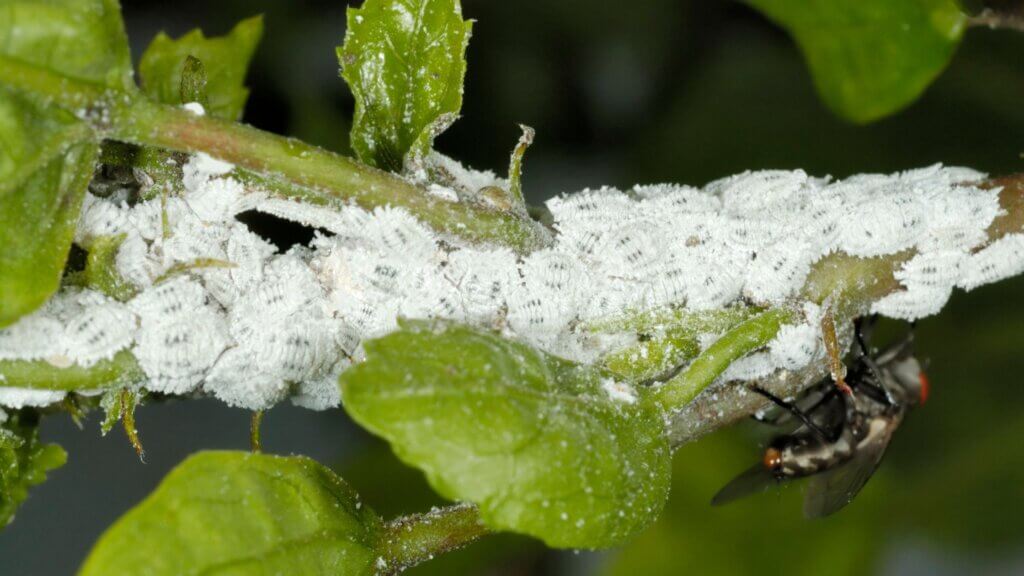
Additional Resources to Deal with Mealybugs
For more in-depth guidance on identifying, treating, and preventing mealybug infestations, explore the following resources:
Plantify: Mealybug Pest Guide
Learn more about mealybugs, how to spot an infestation, and effective treatments for various plant types in this detailed guide from Plantify.
Visit Plantify’s Mealybug GuideEfekto: How to Handle Mealybugs
Efekto provides practical steps on handling mealybug infestations using both chemical and organic treatments.
Read Efekto’s Guide on MealybugsThe Gardener: Mealybug Control
This article offers comprehensive advice on identifying mealybugs and protecting your plants using effective management strategies.
Check Out The Gardener’s Mealybug ArticleGardening in South Africa: Mealybugs on Ornamentals
Learn how mealybugs affect ornamental plants and the best treatment options available in South Africa.
Explore Gardening in South Africa’s Mealybug Resource

